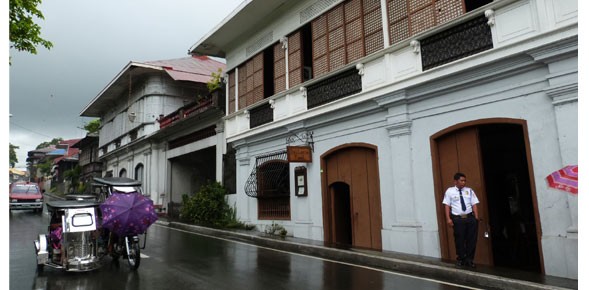Taal City, a mere 120 km south of Manila, is one of the few heritage cities of the Philippines still preserving a high number of historical buildings. It could be a perfect get-away destination from the capital but has so far missed the opportunity to travellers…
TAAL CITY- “Taal? You want to see Taal? What for? Is it for the volcano and the lake?” Requesting to visit the city of Taal, is generally greeted with skepticism by local Filipinos. Taal is indeed to most Filipinos associated with the country’s smallest volcano but also one of its most active. Observed from the nearby Tagaytay Ridge, Taal Volcano in the midst of Taal Lake provides one of the country’s most pictorial shots. Why then to prefer going to the city of Taal?
Few people might know but Taal belongs to the rare cities in the Philippines which still have a rather well-preserved historical legacy. Vigan in Northern Luzon is the most prominent example of Spanish-Filipino architectural heritage and is recognized as such by its listing by UNESCO as a World Heritage Site. But due to wars and a feverish construction boom in the sixties and seventies, they are few examples of heritage areas today. Among them are Cebu (Cental Visayas), Intramuros district in Manila, Iloilo City and Silay in the Western Visayas and… Taal.
Taal is after Vigan probably the second best preserved settlement for Spanish-Filipino architecture. The city has a population of just 50,000 inhabitants and its city centre around the Basilica of St Martin de Tours- Philippines’ largest catholic church and a favourite location for moviemakers and wedding organizers- is filled up with old mansions built in Castillan style.
In Agoncillo Street, Bahay na bato (stone and wooden houses), the typical ancestral homes built hundred years ago, line up. With their old lighting, their traditional windows and fading colours, the houses exult an old world atmosphere. Many of those houses have been turned into museums, restaurants or homestays. There is an interesting camera museum in Taal Gallery which in fact is a perfect place to pay a look at a 19th century mansion as as are the Marcela Agoncillo Museum, which pays homage to a Filpina heroin who created the first independence flag, or the Don Leon Apacible Museum, another noble house with beautiful furniture.
One of Taal’s most delightful experiences takes places in Villa Tortuga. Filipino designer Angelito Perez proposes to have lunch in an exquisite colonial environment. He even proposes to create parties or take pictures in historical costumes. “I felt in love in Taal a few years ago. And I decided then to buy one of these Bahay na bato places to turn it into a distinctive colonial style mansion. All the displayed furnitures are original from my family or antique shops which gives back a sense of grandeur to the house again”, he explains. Perez organizes Villa Tortuga Colonial Tour Package which includes a walk through Taal City, visits to the various museums in town and then having lunch at Villa Tortuga. Rooms can also be rented for accommodation with prices as low as US$ 25.
The only problem that Taal face might be in fact the lack of awareness among travellers. “We received only 37,000 travellers last year from which only 5,000 were probably foreigners,” says Architect Robert Arambulo, Head of the Tourism Office in Taal. But a development on a larger scale will be difficult despite the fact that this year, the city is likely to attract some 60,000 visitors.
“We need more hotel rooms as we just have a few guest homestays and inns for now. We also need to come out with a more comprehensive tourism plan which would delimit tourist areas. We have for example a serious problem with local moto-taxis which are extremely noisy and polluting. They create a disturbance for locals and tourists in the historical area. We need to target this problem,” adds Arambulo.
Taal City is now part of a new initiative launched last year by the Filipino Department of Tourism DoT under the name “Heritage Villages Pilipinas”. Other sites being considered for Heritage Villages Pilipinas are Sabtang, Batanes; Vigan, Ilocos Sur; Bangaan, Banaue in Ifugao; Escolta, Manila; Pila, Laguna; Angono, Rizal; San Miguel, Bulacan; Maragondon, Cavite; Boac, Marinduque; Sariaya, Quezon; Romblon, Romblon; Silay City, Negros Occidental; Carcar, Cebu; Tugaya,Lanao del Sur; and Lake Sebu, South Cotabato.
The project is initially coordinated with the National Commission for Culture and the Arts, National Museum, National Historical Commission, Philippine Tourism Promotions Board, Department of Interior and Local Government. But to really succeed, it will also request an effort of improving local infrastructure and above all, to be known by a larger public. Beyond the brilliant new campaign “It is more fun in the Philippines”, it is also time for the DoT to put more funds into communication and promotion to succeed…
Luc Citrinot a French national is a freelance journalist and consultant in tourism and air transport with over 20 years experience. Based in Paris and Bangkok, he works for various travel and air transport trade publications in Europe and Asia.




![[PR] PR_Ascott and Vimut Hospital_2024](https://www.traveldailynews.asia/wp-content/uploads/2024/04/PR-PR_Ascott-and-Vimut-Hospital_2024-400x265.jpg)



























































